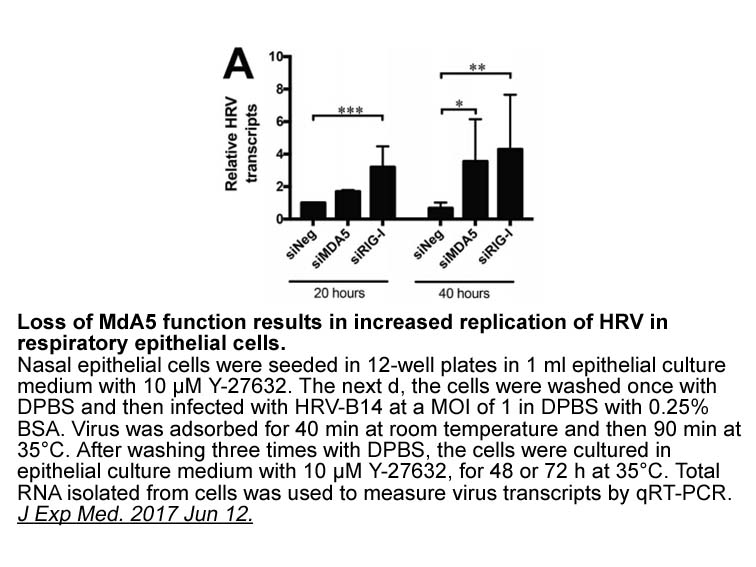Archives
Apelin induced G i activation has been demonstrated
Apelin induced Gαi activation has been demonstrated as a benefiting effect on cardiac contractility [12], [38], [39], and a vasodilator activity that protects against angiotensin-II-induced cardiovascular fibrosis and atheroma [40], [41]. In contrast, stretch causes hypertrophy through diminishing G protein activation while augmenting β-arrestins recruitment. The APJ mediated GRK/β-arrestin signals induced by stretch signals increase cardiomyocyte cell size and play as a crucial role to cause hypertrophy in a G-protein-independent fashion. Further work will be needed to determine the APJ mediated GRK/β-arrestin signals in living cells by BRET and FRET.
Declaration of interest
Funding
This work was supported by National Natural Science Foundation of China (Grant nos. 30971081, 30870932, and 81070961) and Shandong Provincial Natural Science Foundation (Grant nos. ZR2011CM027 and ZR2009DZ004) and Taishan Scholar Construction Special Fund.
Author contributions
Acknowledgment
Introduction
Alzheimer's disease (AD) is a progressive neurodegenerative disorder, and it is considered the most prevalent form of dementia in the elderly. Pathologically, it is characterized by intracellular neurofibrillary tangles (NFTs) and extracellular amyloid beta (Aβ) protein deposits that contribute to senile plaques (Selkoe, 1991). The mutation in the amyloid precursor protein (APP), presenilin (PS) 1 and 2 genes causes high levels of Aβ production, thus resulting in the early onset of AD. Moreover, the ε4allele of Apo lipoprotein E (ApoE) is associated with an increased risk of late-onset AD (St George-Hyslop, 2000; Takeda et al., 2004). Other important factors involved in the pathogenesis of AD include neurotransmitter dysfunctions such as KPT-276 (Coyle et al., 1983), N-methyl d-aspartate receptor (NMDAR)-mediated excitotoxicity (Hynd et al., 2004), oxidative damage (Lin an d Beal, 2006), and inflammation from cytokines and chemokines (Akiyama et al., 2000).
Apelin is a neuropeptide isolated from bovine stomach extracts and is used by neurons to communicate with each other. It is an endogenous ligand for the APJ receptor (Tatemoto et al., 1998). The apelin/APJ system has several important functions in the body, such as blood pressure regulation, cardiac contractility, immunity, glucose metabolism, water homeostasis, cell proliferation, angiogenesis, and neuroprotection (Wu et al., 2017). A study has been shown that serum levels of apelin-13 decreased in AD patients (EREN et al., 2012). In rats with cerebral ischemia/reperfusion (I/R) injury, treatment by apelin-13 significantly decreased neurological deficits and the infarct volume (Xin et al., 2015). In cerebral ischemia mice model, apelin-13 injection significantly protected blood-brain barrier (BBB) from injury through decreasing BBB permeability, elevated vascular endothelial growth factor, upregulated endothelial nitric oxide synthase (eNOS), and downregulated inducible NOS (Chu et al., 2017a). In SOD1G93A mouse model of amyotrophic lateral sclerosis, it has been indicated that apelin deficiency caused decreasing the number of motor neurons and earlier appearance of disease phenotypes and also, accelerated the progression of disease via microglia activation in spinal cord (Kasai et al., 2011). In mice with glioblastoma, an aggressive brain tumor, APJ antagonist, MM54,treatment caused significantly decrease in tumor growth and disrupted the expansion of tumor associated neurological symptoms (Harford-Wright et al., 2017). It is reported that intracerebroventricular (ICV) injection of apelin-13 in traumatic brain injury mice model resulted in reducing of brain damage via autophagy suppressing (Bao et al., 2015). In stressed rats it has been shown that apelin-13 injection accelerated antidepressant-like and recognition memory improving activities via activating phosphatidyl inositol 3-kinases (PI3K) and extracellular signal-regulated kinase1/2 (ERK1/2) signaling pathways. It has been revealed that the hippocampus is a Critical Site of apelin antidepressant-like activity (Li et al., 2016; Xiao et al., 2018). In Parkinsonism rats, apelin-13 injection into the substantia nigra significantly reduced cognitive impairments (Haghparast et al., 2018). In this review, we examine the various factors and mechanisms mediated by apelin that may contribute to the prevention and treatment of AD.
d Beal, 2006), and inflammation from cytokines and chemokines (Akiyama et al., 2000).
Apelin is a neuropeptide isolated from bovine stomach extracts and is used by neurons to communicate with each other. It is an endogenous ligand for the APJ receptor (Tatemoto et al., 1998). The apelin/APJ system has several important functions in the body, such as blood pressure regulation, cardiac contractility, immunity, glucose metabolism, water homeostasis, cell proliferation, angiogenesis, and neuroprotection (Wu et al., 2017). A study has been shown that serum levels of apelin-13 decreased in AD patients (EREN et al., 2012). In rats with cerebral ischemia/reperfusion (I/R) injury, treatment by apelin-13 significantly decreased neurological deficits and the infarct volume (Xin et al., 2015). In cerebral ischemia mice model, apelin-13 injection significantly protected blood-brain barrier (BBB) from injury through decreasing BBB permeability, elevated vascular endothelial growth factor, upregulated endothelial nitric oxide synthase (eNOS), and downregulated inducible NOS (Chu et al., 2017a). In SOD1G93A mouse model of amyotrophic lateral sclerosis, it has been indicated that apelin deficiency caused decreasing the number of motor neurons and earlier appearance of disease phenotypes and also, accelerated the progression of disease via microglia activation in spinal cord (Kasai et al., 2011). In mice with glioblastoma, an aggressive brain tumor, APJ antagonist, MM54,treatment caused significantly decrease in tumor growth and disrupted the expansion of tumor associated neurological symptoms (Harford-Wright et al., 2017). It is reported that intracerebroventricular (ICV) injection of apelin-13 in traumatic brain injury mice model resulted in reducing of brain damage via autophagy suppressing (Bao et al., 2015). In stressed rats it has been shown that apelin-13 injection accelerated antidepressant-like and recognition memory improving activities via activating phosphatidyl inositol 3-kinases (PI3K) and extracellular signal-regulated kinase1/2 (ERK1/2) signaling pathways. It has been revealed that the hippocampus is a Critical Site of apelin antidepressant-like activity (Li et al., 2016; Xiao et al., 2018). In Parkinsonism rats, apelin-13 injection into the substantia nigra significantly reduced cognitive impairments (Haghparast et al., 2018). In this review, we examine the various factors and mechanisms mediated by apelin that may contribute to the prevention and treatment of AD.